
typicus antenna
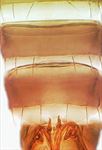
typicus sternites VI-VII
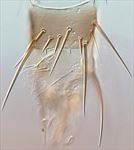
typicus male tergite IX
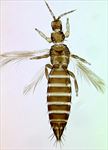
usitatus female
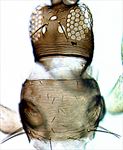
usitatus head & pronotum

usitatus antennal segments V-VIII

usitatus sternites VI-VII
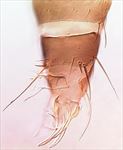
usitatus male tergite IX

haopingensis fore wing
Generic diagnosis
Female macropterous. Head scarcely wider than long; maxillary palps 3-segmented; eyes with five weakly pigmented facets; ocellar setae I present; setae III elongate; five pairs of postocular setae. Antennae 8-segmented, segment I with paired dorso-apical setae, III and IV with elongate forked sense cones, III–VI with some microtrichia on both surfaces; VI with base of sense cone elongate. Pronotum with two pairs of long posteroangular setae; four pairs of posteromarginal setae. Mesonotum with median pair of setae near posterior margin; campaniform sensilla present. Metanotum weakly reticulate; median pair of setae at anterior margin; campaniform sensilla present. Fore wing first vein with short gap in setal row near apex, 13–15 basal and 2 distal setae; second vein with many setae equally spaced; clavus with five veinal and one discal setae; posteromarginal fringe cilia wavy. Prosternal ferna not divided; basantra membranous, without setae; prospinasternum broad and transverse. Mesosternum with sternopleural sutures complete; endofurca with spinula. Metasternal endofurca without spinula. Tarsi 2-segmented. Tergites without craspeda or ctenidia; VIII with irregular group of microtrichia anterolateral to each spiracle; VIII with posteromarginal comb present laterally but not medially; tergite IX with two pairs of campaniform sensilla, MD setae present; X with longitudinal median split incomplete. Sternites without craspeda or discal setae; III–VII with three pairs of posteromarginal setae, II with two pairs; sternite VII with S1 setae at or anterior to posterior margin; laterotergites without discal setae.
Male similar to female; tergite IX posterior margin usually with a pair of short stout setae laterally, often with paired small marginal tubercles medially; sternites without pore plates.
Biological data
Apparently breeding only in the flowers of Fabaceae, including many crops of cultivated beans as well as some tree species in the family Fabaceae.
Distribution data
This is an Old World genus, with most described species being from Asia, although two of them have been introduced and established in Florida. Several of the species described from China are possibly unrecognised synonyms (Mirab-balou et al., 2014).
Nomenclatural data
Megalurothrips Bagnall, 1915: 589. Type species Megalurothrips typicus Bagnall, 1915, by monotypy.
Although 14 species are listed in this genus (ThripsWiki, 2018), the significance of some of the 11 listed from China that were based only on females remains in doubt. For example, longus was based only on males that have the same character states as the type species:
basisetae Han & Cui, 1992: 424 (433)
distalis (Karny, 1913: 122). (Taeniothrips)
equaletae Feng, Chao & Ma, 1999: 261.
flaviflagellus Mirab-Balou, Yang & Tong, 2014: 382.
formosae (Moulton, 1928: 298). (Taeniothrips)
guizhouensis Zhang, Feng, & Zhang, 2004: 165.
haopingensis Feng, Chao & Ma, 1999: 262.
longus Hu QL & Feng JN, 2019: 279.
peculiaris (Bagnall, 1918: 206). (Physothrips)
typicus Bagnall, 1915: 590.
usitatus (Bagnall, 1913: 293). (Physothrips)
Relationship data
Thripidae sub-family Thripinae: this is a diverse group involving more than 230 genera. Megalurothrips is closely related to Odontothrips, with which it shares structural and biological characteristics, although the base of the sense cone on antennal segment VI is smaller in Megalurothrips than in Odontothrips species. The members of these two genera have a pair of dorso-apical setae on the first antennal segment, and include many species that can be securely identified only if males are available (Palmer, 1987).
References
Mirab-Balou M, Yang S-L & Tong X (2014) Description of a New Species of the Genus Megalurothrips (Thysanoptera: Thripidae) from China. Entomological News 123 (5): 380–386.
Palmer JM (1987) Megalurothrips in the flowers of tropical legumes: a morphometric study. In Holman J, Pelikan J, Dixon AFG & Weismann L. [eds] Population structure, genetics and taxonomy of aphids and Thysanoptera. The Hague (SPB Academic Publishing): 480–495.
ThripsWiki (2020). ThripsWiki - providing information on the World's thrips. <http://thrips.info/wiki/Main_Page>